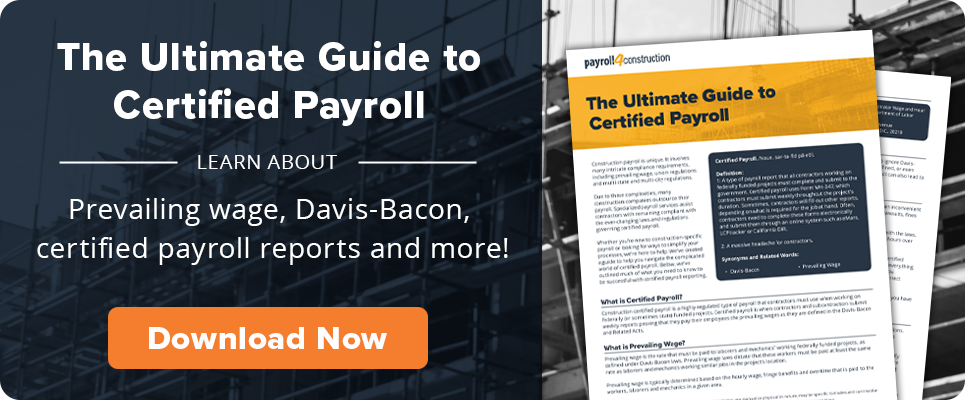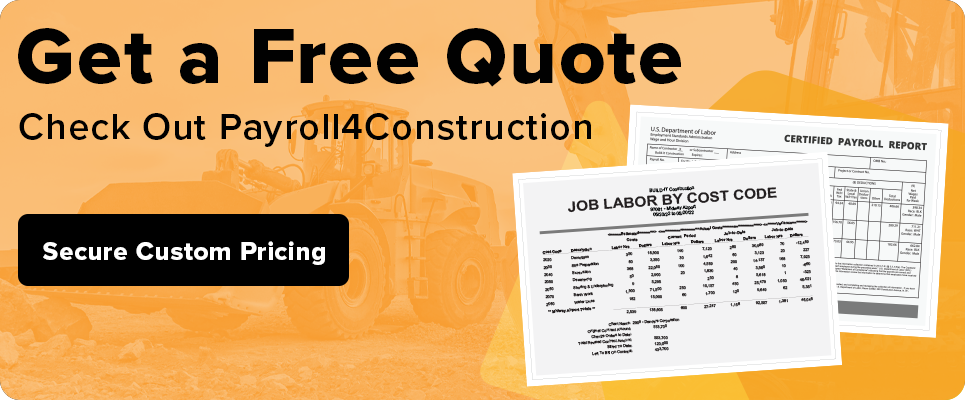
September 27, 2022
Federally funded construction projects are attractive — offering appealing benefits like long-term employment, flexible work, good income, timely payments, and stable contracts. Not to mention lots of opportunities for profit — in 2020 alone the United States government invested over $665 billion in contractual construction services and supplies.1 But not every contractor is rushing to bid on government work. Why? Federal projects involve an array of labor laws and wage regulations that can be difficult to track and report.
One reporting requirement that receives quite a bit of attention is certified payroll. But to understand certified payroll, you must first understand the concept of prevailing wage. Prevailing wage is the minimum amount an employer can pay their laborers while they work a government-funded job.
Legally, any contractor working on a government project must prove they’re paying their laborers the prevailing wage of the area in which they’re working. Certified payroll is the proof. And certified payroll isn’t just expected with federal projects — states and cities are also requiring some format of this report — so if you want government work, you need to be prepared.
Certified payroll has a reputation for being complex. Which is fair, considering report formats change depending on locality and the reporting requirements vary depending on how many jobs a worker does each week. Nonetheless, certified payroll is manageable and can lead to lucrative opportunities.
We’re going to break down the reporting process and make everything more accessible — certified payroll can be complicated, but it doesn’t have to be daunting.
(Read 4 Tips To Help With Union Payroll Reporting.)
The Davis-Bacon Act of 1931
Certified payroll — regardless of its complexities — is a necessary requirement, acting as an equalizer in the bidding competitions for government projects. In the early 20th century, there was an imbalance among construction competitors — those who paid their workers less wages were able to offer a lower quote for the job, typically winning the work over companies who opted to give their laborers higher pay.
To make the bidding process fairer, the Davis-Bacon Act of 1931 was passed — mandating all companies who work on government projects to pay the prevailing wage. This law continues to ensure that skilled local workers are not being overlooked in favor of workers who accept much lower wages.
The Different Ways to Pay Prevailing Wage
Contract permitting, there are a few different ways a company can pay their employees who are working on government projects. These methods of payment include:
- Flat Rate – the wage provided to laborers working on government-funded projects equals or exceeds the prevailing wage. For example, if the prevailing wage is $20, then the laborer is paid $20 or more.
- Wage + Benefits – the wage itself is below the prevailing standard, but additional money is provided hourly to the laborers as a prevailing wage fringe (401k, health insurance, vacation, etc.).
No matter what, the prevailing wage has to be met in some capacity. Contractors usually don’t have a choice in the matter — it all depends on what the contract of the prevailing wage job permits. If a contractor has a choice, then the best option will depend on company circumstances, like the size of the workforce or the bandwidth of the budget.
What Makes Up a Certified Payroll Report?
A certified payroll report is traditionally submitted on a WH-347 form. However, these reports can technically be filled out in a variety of formats. City, state, and federal forms can all differ depending on what information the respective agency wants to see. To know which form is required for a specific government job, research the regulations of the state or department in charge of the project.
Certified payroll formats are put together in two different ways:
- Print Certified Payroll Report Formats
- Electronic Certified Payroll Report Formats
Keep in mind that certified payroll has evolved alongside technological advances. This means some reporting agencies may not only demand the printed paper copy but also expect digitalized versions as well.
Although each reporting agency has different certified payroll requirements, there are some similar pieces of information requested on all forms, such as:
- Employee Information — An employee’s personal information such as their name, address, and (potentially) social security number.
- Hours — The hours an employee worked that week and a complete breakdown of the pay rates for those hours (especially the hours considered prevailing wage).
- Earnings — An employee’s gross and net earnings for the week.
- Taxes & Deductions — An employee’s tax withholdings and deductions taken out of the prevailing wage earnings.
- Fringe Benefits — Any fringe benefits provided to the employee for the week that are associated with the prevailing wage.
Agencies may require extra steps when it comes to reporting mandated information. However, by having these specific details accessible, the process of filing certified payroll can run more efficiently.
How to Create a Certified Payroll Report
Certified payroll is confirming two things:
- The contractor is paying their workers the correct prevailing wage — as outlined by their contract.
- The construction company is paying taxes on all earned dollars that are taxable.
The actual report is the proof of accountability. It includes the following:
- A breakdown of the total number of hours worked by an employee to highlight which hours are considered prevailing wage.
- The taxes, potential fringe benefits, and, in some cases, garnishments that are being paid out of the prevailing wage labor hours.
There are two main ways to put together a certified payroll form:
- Manual Entry – The administration either writes or types out all employee information each week.
- Construction Accounting Software – A construction-specific payroll service will automatically generate certified payroll reports weekly. Contractors can flag the jobs with prevailing wages, and the correct wages will become the default in the system.
Complexities occur when laborers perform varying jobs throughout the week. A construction worker can start off in one position, switch to a different city, and then end the week in a whole new role. These 40 hours now involve different localities and job titles. Some hours are prevailing wage while others are a new rate. All of this information has to be broken down in the report for each worker.
Manual entry can still be a viable option as long as the administrator is able to dissect each worker’s hours and taxes. But for those contractors working with limited amounts of time, construction accounting software can be a great asset since the software is equipped to itemize workers’ hours automatically.
Who is Certified Payroll Reported To?
Certified payroll is mandated federally but implemented locally. Meaning, the agency you submit your report to is determined by the government body providing the funding. For example, if a construction company is part of a street pavement campaign for a state, then the certified payroll report is given to the department or bureau of labor operating in that state.
Below are some examples of common departments managing the certified payroll in their region:
- City/Province — Mayor’s Office, Department of Wage Information
- State — Department of Commerce, Wage and Hour Administration
- Federal — The Department of Labor
Some states and cities will have different names for their reporting agency. Once you win a job — before the work even starts — find out the name of the reporting office and request a list of their requirements.
The Importance of Being Certified Payroll Compliant
Following all compliance regulations is essential for companies working on government projects. There are repercussions for those who fail to comply or who inaccurately report information. Penalties include:
- Payment Holds — The government will hold company paychecks until the certified payroll report is complete and accurate.
- Fines — If a company continues to make errors on their certified payroll reports they will be charged for their consistent mistakes.
- Ban Status — After a company has a sustained period of inaccurate certified payroll reports, they can be refuted from all government work — on any level — for however long the sentencing body determines.
Now keep in mind these penalties are only part of the story. Being certified payroll compliant also has benefits contractors can take advantage of, such as:
- Win More Recession-Proof Work — Government projects will never dry up. Even during economic turmoil, there will still be federal money given to states and cities for different endeavors. Having a strong record of compliance can give construction companies a competitive edge during bidding.
- On Time Payments from Subcontractors — The government body funding a project will give a weekly lump sum to the general contractor who will then distribute the money into payments for their subcontractors. General contractors can establish agreements with subs requiring them to pay fees on time or risk delayed paychecks in the future.
- Attract and Retain Skilled Employees — Trained laborers are attracted to government-funded construction companies because there is a guarantee of consistent work, mandated good pay, and the potential for fringe benefits. During periods of labor shortages, this alone can make a huge difference in whether a worker stays with a company.
The truth is if you want government-funded work then compliance is absolutely necessary. Instead of being intimidated, be prepared. Allot a proper amount of time and focus for certified payroll and have resources available to check over all the information for accuracy. Once you’re confident in your reporting, you can take advantage of your compliance and win big jobs.
Master Certified Payroll And Take On More Federally Funded Projects
There are nuances to certified payroll, but there are also lucrative perks to working on government projects. If you’re interested in winning some of these jobs, then it’s worth the time needed to learn, research, and explore. Consider capitalizing on some of the following resources:
- Government Representatives – Talk to labor department officials to find out about how certified payroll is conducted in your local cities and adjacent states (depending on the jobs you’re interested in).
- Accounting Software Service Providers – If you don’t have the time or personnel to manage certified payroll, go straight to the experts so they can handle all the complexities of prevailing wage while you focus on other administrative necessities.
- Local Opportunities – Remember, you can start small. While you’re gaining experience with the reporting process, bid for city projects and build yourself up to state and federal work.
By taking the time to break down prevailing wage and certified payroll, you’ll be better familiar with the pieces involved in the reporting process. The more knowledge and experience you gain, the more comfortable you’ll be filing your reports, leading to more opportunities to have success on government projects.
1 DiNapoli, Timothy J. “A Snapshot of Government – Wide Contracting for FY 2020 (Infographic).” U.S. Government Accountability Office. June 22, 2021. https://www.gao.gov/blog/snapshot-government-wide-contracting-fy-2020-infographic
Share Article
Keep on current news in the construction industry. Subscribe to free eNews!


